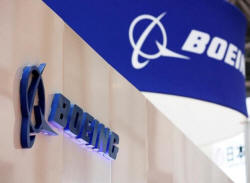Jetmakers battle over niche where Boeing plans new jet
 Send a link to a friend
Send a link to a friend
 [February 05, 2018]
By Tim Hepher and Jamie Freed [February 05, 2018]
By Tim Hepher and Jamie Freed
SINGAPORE (Reuters) - Boeing played up the
prospects for a potential new mid-market jet on the eve of the Singapore
Airshow on Monday - but the war for sales has already begun in this area
of the market worth hundreds of billions of dollars over the next 20
years.
Even before Boeing decides whether to launch its much-touted new jet,
the U.S. planemaker and European rival Airbus are stepping up sales of
existing models to seize market share and disrupt each other's profits
without the temporary respite many had been expecting after a busier
than expected 2017.
Their battle is focused on aircraft with around 200-270 seats, where
Boeing leads at the top end with its twin-aisle 787 Dreamliner and
Airbus seeks to maintain its dominance of the largest single-aisle
planes like the A321neo, executives say.
Although few immediate orders are expected, aggressive sales pitches
have increased the tension going into this week's air show, where
airlines will be hoping for updates on Boeing's development plans and
Airbus's possible response.

After trouncing Airbus in the market for wide-body planes last year,
Boeing is trying to seize the advantage by directly targeting Airbus's
slow-selling A330neo with further sales to airlines of its competing
787, several industry sources said.
Airbus, by contrast, hopes to keep pumping its hot-selling single-aisle
AA321neo into the market to minimize the space left for Boeing in the
niche between single-aisle and long-haul jets, where Boeing's new jet is
waiting on the drawing board.
"You can expect Airbus to be pushing as many A321s as possible this
year. Boeing is attacking the A330neo wherever it pops up," said the
fleet manager of a large Western airline.
Several U.S. airlines and low-cost, long-haul carriers such as Level,
part of the IAG group, are comparing the Boeing 787 and the recently
upgraded A330neo as competition intensifies, market sources said.
Even AirAsia, Airbus's top Asian customer, has said it is considering
the Boeing 787 for long-haul operations, in what would be a significant
upset for the European company.

[to top of second column] |

Boeing's logo is seen during the Japan Aerospace 2016 air show in
Tokyo, Japan, October 12, 2016. REUTERS/Kim Kyung-Hoon/File Photo

Airbus officials were not available for comment.
INTERNAL GOAL
Boeing's potential new mid-market jet would seat 225 to 275 people and enter
service in the middle of next decade, senior vice president Dinesh Keskar told
reporters, adding interest was coming from markets like Australia, India and the
Middle East.
Asked about expectations that Boeing would launch the plane this year, he said,
"Certainly the interest is there and we continue to have our dialogue with
customers".
Airbus argues it already controls much of that space with its 185-240-seat
A321neo, which boasts 80 percent of comparable sales, and the albeit
less-in-demand A330neo wide-body.
But despite winning the 2017 order battle thanks to a record deal for small
jets, Airbus took a severe hit in the high-margin wide-body market, where Boeing
won three times as many orders.
Airbus has shrugged off the loss, claiming a 50 percent share of average sales
over 10 years. But privately, it has made closing the gap its top internal goal
this year, sources say.
These concerns have intensified as Airbus faces a wave of new departures
following the retirement of sales chief John Leahy, who is in Singapore this
week to facilitate the handover to his successor, ex-Rolls-Royce executive Eric
Schulz.

"The A330neo is a big priority for Airbus this year in sales," BOC Aviation
Chief Executive Robert Martin told Reuters.
"There are new markets opening up this year for mid-sized wide bodies. India is
probably going to have more growth ... Maybe some of the U.S. majors will add to
their growth. I think we are going to see a big battleground in this area."
(Additional reporting by Brenda Goh. Editing by Jane Merriman)
[© 2018 Thomson Reuters. All rights
reserved.] Copyright 2018 Reuters. All rights reserved. This material may not be published,
broadcast, rewritten or redistributed.
Thompson Reuters is solely responsible for this content. |